Halfway Oak
When I heard that my longtime friend was heading down from the greater New York City area to visit his family in Abilene, the wheels turned in my mind to figure out how I could visit him and see another tree.
Scanning the old map in my first edition book, I saw the dot for the Original Burkett Pecan, which looked like the closest to Abilene. Unfortunately, this one is no longer with us.
Next, I did a bit of digging to see if I could get permission to visit the District Court Oak in Weatherford, which does not have public access. I tried the no-longer-in-service number that Google provided for the dairy on which it is supposed to be located. Then I rang the City of Weatherford, which routed me via phone tree to the helpful folks at the library. They didn’t have any info, but gave me the number of a master gardeners group who were similarly friendly and willing to assist, but came up short on specifics.
I gave up on that trail, but later learned that my arborist friend has seen it on a tour of trees, so perhaps I can get to it down the line.
I settled instead on visiting one that wasn’t in my older editions of The Famous Trees of Texas, since it wasn’t designated “famous” until 2011. The Halfway Oak is approximately halfway between the towns of Breckenridge and Cisco, Texas, which are both within an hour or so of Abilene. Directions state that it is 13 miles south of Breckenridge. Its exact location wasn’t clear. Studying the map in preparation, it seemed sensible to head toward Cisco, then take US highway 183 north to see if I could spot it. This was before I knew about the website.
The description stated that it would be obvious and it was indeed, clear from the road that this was it. The area looks like a classic rest stop with red guard railing and a single picnic table on the sparsely trafficked highway. Though I passed a few other good sized decoys along the way, this tree was large enough to command attention out in the middle of nowhere.
Feeling elated and victorious having found what I was looking for without a map, I decided again to take a bit of video, after my first attempt at the Houston Campsite Oak. This time catching my very first impression as I stepped out of my car, the motion picture accompaniment adds another dimension for my record of still images and rambling words. Hopefully my presence doesn’t come across as self absorbed. Anyway, it’s two minutes. You decide.
The wind was whipping in this wide open area. The big ol’ Texas sky was in full effect with nothing to block it. An occasional car whizzed past creating yet another audible gust as I walked under the imperfectly staggered and broken tree canopy. Storms, drought, bad pruning and other mishaps mentioned in the write up make the existence of this ancient tree, used as a shady place of pause along the road for decades, even more impressive.
Live oaks often grow in clusters. Seedlings germinate and grow together, and multiple trunks sprout from the root base as suckers. Over decades, the trunks widen alongside each other sprawling out from a central point, forming a united, multi-trunked plant called a motte.
Peering into the deeply fragmented trunks, some split and laying on the ground, several propped up by supports, but still alive and joined to the central group, I noted multiple wounds and once healthy trunks now disintegrating.
When I venture close to a giant living being such as this with no one else around, it feels like all the molecules buzz a little bit. I’ve entered a special energy space, with the enclosure of branches surrounding me.
The wild wind made my eyes water non stop, but even though they weren’t tears of emotion, it sort of felt appropriate to release something. I walked around taking in every part of this wide sprawling, falling over tree, appreciating the enormous blue sky and wispy clouds as well.
My book calls them “famous” trees, but very few are aware of them. Aside from my coincidental meeting at Old Baldy, I almost never see anyone else deliberately visiting.
In 2016, I visited the second largest tree in the world, along with a group of astounding sequoias in General Grant Grove in Kings Canyon National Park.
The photo-crazed crowds around them were obnoxious! I retained a mental image of one girl sticking her leg up on a trunk in a cheerleader-type splits pose, undoubtedly meant for social media. Of course, I posted pix of Grant as well. Perhaps I wasn’t in the most charitable frame of mind wanting the amazing sequoias all to myself.
After I had slowly circled the sight and was reading the historical marker, another driver rode up. He kept a respectful distance near his vehicle and as we made a bit of small talk about the historic specimen, he mentioned he had recently started working for a local arborist.
As with almost every tree I have seen, a warm surge of gratitude surfaced, both for receiving my time alone with the big oak, and also that it deservedly had more visitors than just me. I waved and walked back to my car, looking forward to seeing my friend in Abilene. Another car full of people pulled in just as I drove away.




















Though we enjoyed a good long visit together, my friend and I failed to get even a single photo together, so I asked him to send me one of him and his 87 year old mother Peggy.














